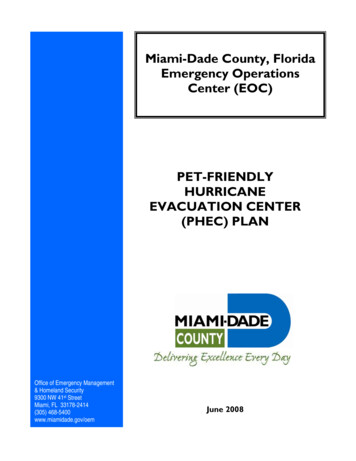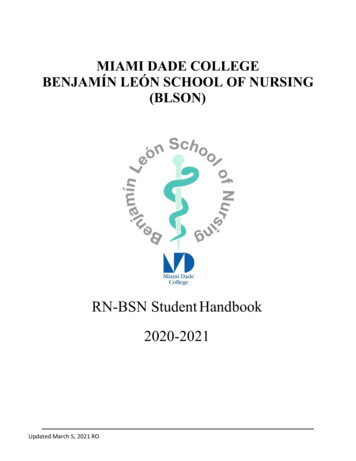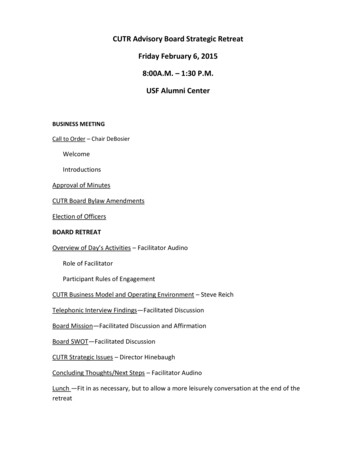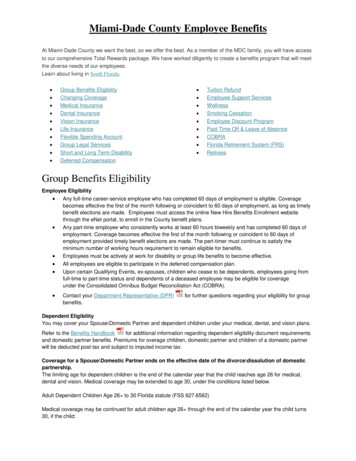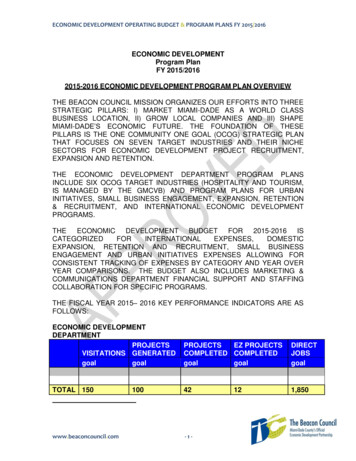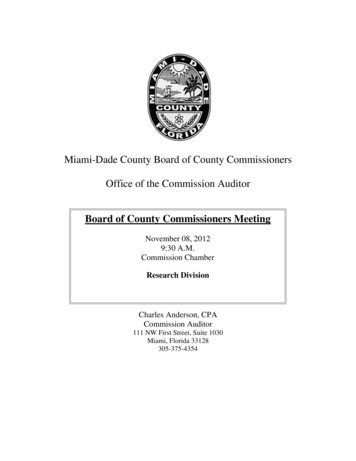
Transcription
Miami-Dade County Board of County CommissionersOffice of the Commission AuditorBoard of County Commissioners MeetingNovember 08, 20129:30 A.M.Commission ChamberResearch DivisionCharles Anderson, CPACommission Auditor111 NW First Street, Suite 1030Miami, Florida 33128305-375-4354
Miami-Dade County Board of County CommissionersMeeting AgendaNovember 08, 2012Item nowledgements:Bia Marsellos, Senior Legislative AnalystMichael Amador-Gil, Senior Legislative AnalystElizabeth Owens, Legislative Analyst
MIAMI‐DADE COUNTYBOARD OF COUNTY COMMISSIONERSOFFICE OF THE COMMISSION AUDITORResearch NotesAgenda Item:5AFile Number:121524Date of Analysis:October 17, 2012SummaryThis ordinance: (1) repeals section 30‐422 of the code of Miami‐Dade County, Florida; (2) repeals the authority touse traffic infraction detectors/red light cameras in the Unincorporated Area of Miami‐Dade County, Florida; (3)repeals Resolution 759‐10, removing direction and authority to the mayor or designee to implement a red lightcamera program in Miami‐Dade County; and (4) sets policy that no red light camera program will be implementedor maintained by Miami‐Dade County in the Unincorporated Area or on County roads.The Mark Wandall Act authorizes the use of cameras for traffic enforcement in Florida and requires cameras to betested regularly and to comply with specifications established by the Florida Department of Transportation. TheAct was named after Mark Wandall, a man who was killed by a red‐light runner in 2003.Florida Statute 316.0083 provides for a 158 fine, which is distributed as follows: 75 – Retained by the City or County where the violation took place 70 – Remitted to the Department of Revenue (DOR) 10 – Remitted to DOR for deposit into the Department of Health Administrative Trust Fund 3 – Remitted to DOR for deposit into the Brain and Spinal Cord Injury Trust FundRecent Red Light Camera LegislationOn February 7, 2012, the Board of County Commissioners (BCC), through R‐151‐12, directed the County Mayor orhis designee to prepare a report within 60 days detailing the best methodology and implementation schedule tosynchronize traffic signals at high crash, high volume intersections within Miami‐Dade County to provide a four‐second all‐red clearance interval between signal phases. The purpose for this legislation is to curb the use of redlight cameras at busy intersections and implement a four‐second all red clearance interval.Around the same time, the Florida House of Representatives temporarily postponed consideration of HB 343 re:red light cameras. HB 343 would have imposed additional requirements on red light cameras, such as accuracytesting of red light cameras every six months. A new version of HB 343 filed for consideration would haveeliminated the 75 that the local government receives from a red light camera ticket.Additional BCC Legislative ActionBCC DateLegislative Action8/23/05Directed the County Manager to explore the feasibility, cost and benefit of installing camerasat certain dangerous intersections with traffic signals to curb red‐light running.R‐937‐0511/6/07Urged the Florida Legislature to allow the use of unmanned cameras at intersections withtraffic signals in an effort to reduce red‐light running.R‐1248‐073
7/8/10R‐759‐109/16/10See File No.102086Established policy for Miami‐Dade County authorizing the installation of red light cameras athigh crash, high volume intersections; and directed the Mayor or his designee to implement ared light camera program in Miami‐Dade County.The Health, Public Safety and Intergovernmental Committee deferred a resolution directingthe Mayor or designee to study the feasibility of negotiation with municipalities in Miami‐Dade County to create a single, uniform countywide program for red light cameras withrevenues generated in municipalities to be provided to such municipalities.Nationwide Fatality Statistics and 2012 Florida Municipalities Operating Red Light CamerasA 2011 study, titled, Effects of red light camera enforcement on fatal crashes in large U.S. cities, conducted by theInsurance Institute for Highway Safety (IIHS) identified that From the 99 large U.S. cities with more than 200,000residents in 2008, 14 cities had red light camera enforcement programs for all of 2004‐2008 but not at any timeduring 1992‐1996, and 48 cities were identified without camera programs during either period. Analyses comparedthe citywide per capita rate of fatal red light running crashes and the citywide per capita rate of all fatal crashes atsignalized intersections during the two study periods, and rate changes then were compared for cities with andwithout cameras programs. The study states that the average annual rate of fatal red light running crashes declined for both studygroups, but the decline was larger for cities with red light camera enforcement programs than for citieswithout camera programs (35% vs. 14%). The average annual rate of all fatal crashes at signalizedintersections decreased by 14% for cities with camera programs and increased slightly (2%) for citieswithout cameras.After controlling for population density and land area, the rate of fatal red light running crashes during2004‐2008 for cities with camera programs was an estimated 24% lower than what would have beenexpected without cameras. The rate of all fatal crashes at signalized intersections during 2004‐2008 forcities with camera programs was an estimated 17% lower than what would have been expected withoutcameras.The study concluded that Red light camera enforcement programs were associated with a statisticallysignificant reduction in the citywide rate of fatal red light running crashes and a smaller but still significantreduction in the rate of all fatal crashes at signalized intersections.In a January 2012 study, University of South Florida (USF) researchers argued that the February 2011 IIHS analysis(mentioned above) was logically flawed and violated basic scientific methods.Specifically, the USF study argued that the IIHS analysis actually found that Red Light Cameras (RLCs) had a 25percent higher red light running fatality rate during the “after” period than non‐RLCs. In addition, USF researcherspointed out, but did not limit their concerns to, the following regarding the IIHS analysis: It analyzed city‐wide data, not specific to camera sites.It excluded variables known to be associated with traffic fatalities, such as changes in public policy orengineering improvements made during or between the periods.It expressed its findings as a percentage change in the rate of red light running fatalities,‟ instead of achange in the number of fatalities. In other words, USF researchers agued the results of the IIHS analysisare misleading because certain variables – namely those relating to population – are reported multipletimes. For example, population is a denominator, “fatalities per 100,000,” as well as a numerator,“population per square mile.”It was biased in its selection of both RLCs and non‐RLCs. Specifically, USF researchers argued “the authorsof the IIHS study ignored the fact that the non‐RLCs had substantially fewer red light running relatedfatalities in the “before‟ period . . . [o]f even greater impact, 23 percent of the non‐RLCs had two or fewer(including zero) red light running related accidents.” Essentially, USF researchers argued that the non‐RLCs4
had very little room to reduce the total number – or percentage rate – of accidents during the afterperiod.Municipalities in Florida that currently operate red light programs:Apopka; Aventura; Bal Harbour; Boca Raton; Boynton Beach; Bradenton; Brooksville; Casselberry; Clearwater;Cocoa Beach; Collier County; Coral Gables; Coral Springs; Cutler Bay; Daytona; DeLand; Doral; Dunnellon;Eatonville; El Portal; Florida City; Fort Lauderdale; Fort Meyers; Green Cove Springs; Gulf Breeze; Gulfport; HainesCity; Hallandale Beach; Hialeah; Hillsborough County; Holly Hill; Hollywood; Homestead; Juno Beach; Jupiter;Kenneth City; Key Biscayne; Kissimmee; Lake Worth; Lakeland; Maitland; Margate; Medley; Miami; MiamiGardens; Miami Springs; Milton; New Port Richey; North Miami; North Miami Beach; Oakville; Ocoee; Oldsmar;Orange County; Orlando; Palm Beach County; Palm Coast; Pembroke Pines; Port Richey; Sarasota; South Pasadena;St. Petersburg; Sunny Isles Beach; Sunrise; Sweetwater; Tallahassee; Tampa; Temple Terrace; West Boca; WestPark; Winter Park; and Winter Springs.Source: National Highway Traffic Safety Administration and Insurance Institute for Highway Safety, August 2012Prepared by: Michael Amador‐Gil5
MIAMI‐DADE COUNTYBOARD OF COUNTY COMMISSIONERSOFFICE OF THE COMMISSION AUDITORResearch NotesAgenda Item:7A ‐ Regulations on Boat StorageFile Number:121520Date of Analysis:August 24, 2012SummaryThe proposed ordinance pertaining to zoning modifies regulations on boat storage in certain zoning districts,requiring additional buffering; limiting number of boats; prohibiting commercial boat parking; and amending section33‐20 of the Code of Miami‐Dade County (Code).The proposed ordinance will only impact the Unincorporated Municipal Services Area (UMSA).Section of Code33‐20(e)Accessorybuildings;Utility Sheds,SwimmingPools; FalloutShelters; y Sheds,SwimmingPools; FalloutShelters; BoatStoragesComparison of Miami‐Dade County Current Zoning Code and Proposed AmendmentsRegulations on Boat StorageCurrentProposed AmendmentsBoat storage. Boats of less than thirty(30) feet in length, not more than onehundred and two (102) inches inwidth and thirteen (13) feet six (6)inches in height, may be stored ortemporarily parked in the RU, EU, AUand GU Zoning Districts subject to thefollowing conditions:The place of storage shall be to therear of the front building line. Wherethe boat storage area is locatedbetween the residence and a sidestreet property line, the boat shall bevisually buffered by a six‐foot woodprivacy fence, masonry wall, trees orshrubs maintained to a height of sixfeet. The front building line referredto shall be that portion furthest fromthe street.Boat storage. Boats of less than thirty (30) feetin length, not more than one hundred and two(102) inches in width and thirteen (13) feet six(6) inches in height above grade, may bestored or temporarily parked in the RU, EU, AUand GU Zoning Districts on lots developed witha residential structure subject to the followingconditions:Sites with less than one‐half (0.5) acre of lotarea shall be permitted to store up to one (1)boat. The place of storage shall be to the rearof the front building line of the residentialstructure. Where the boat storage area islocated between the residence and a sidestreet property line, the boat shall be visuallybuffered by a minimum six‐foot high privacyfence, masonry wall, or trees or shrubsmaintained to a minimum height of six feet.The front building line referred to shall be thatportion furthest from the street.6Comments onProposedAmendmentsAdds above gradeto heightrequirement andspecifies lotsdeveloped with aresidentialstructure.The proposedamendments are inbold.Adds thespecification thatthis requirement isfor sites with lessthan one‐half (0.5)acre of lot areaallowing for one (1)boat to be stored.Takes out thedescription of theprivacy fence to bewood and providefurther clarificationin regards to theminimum height
y Sheds,SwimmingPools; FalloutShelters; y Sheds,SwimmingPools; FalloutShelters; y Sheds,SwimmingPools; FalloutShelters; BoatStoragesMisc.No more than one (1) boat may bestored or parked on any one (1)premise.N/AN/ASites containing a minimum of one‐half (0.5)acre of lot area shall be permitted to store upto two (2) boats. Sites containing a minimumof five (5) acres of lot area shall be permittedto store up to three (3) boats. The place ofstorage shall be to the rear of the frontbuilding line of the residential structure, andsuch front building line shall be that portionfurthest from the street. Where two or moreboats are located on a site, the boat storagearea shall meet the rear and side setbackrequirements for the principal structure andbe visually buffered from the adjacentproperty and right‐of‐way by a minimum six‐foot high privacy fence, masonry wall or treesor shrubs maintained to a minimum height ofsix feet, provided however, if a permit wasapproved for a five‐foot high privacy fence ormasonry wall prior to the effective date ofthis ordinance and thereafter constructed,such a fence or wall shall be acceptable in lieuof one that is six‐feet high.Up to two (2) personal watercrafts notexceeding five (5) feet in width by twelve (12)feet in length may be stored or parked in lieuof a boat authorized by this section. Suchwatercraft shall be visually buffered inaccordance with Section 33‐20(e)(2) or (3), asapplicable.Commercial boat parking shall be prohibited.All boats stored on the property must beregistered to the property owner orauthorized residential tenant.The proposedamendments are inbold.Provides detailedregulations for thissubsection of theCode.Increases theamount of boatsthat can be stored.Adds new section.Adds regulationsfor personalwatercrafts whichare currently notpart of the Code.Creates section ofthe CodeprohibitingCommercial Boats.In addition, the proposed ordinance provides for housekeeping amendments renumbering the Code tocorrespond to the amended subsections.Prepared by: Elizabeth N. Owens7
MIAMI‐DADE COUNTYBOARD OF COUNTY COMMISSIONERSOFFICE OF THE COMMISSION AUDITORResearch NotesAgenda Item:7D ‐ Zoning Utility Sheds and PergolasFile Number:121734Date of Analysis:August 24, 2012SummaryThe proposed ordinance related to Zoning, amends sections of the Miami‐Dade County Code (Code), modifying therequirements for utility sheds and pergolas.The following sections of the Code are amended under the proposed ordinance: Section 33‐1, Zoning Definitions; Section 33‐20, Accessory buildings; Utility Sheds, Swimming Pools; Fallout Shelters; Boat Storages; Section 33‐199, Uses Permitted in the RU‐1, Single‐Family Residential District; Section 33‐201, Uses Permitted in the RU‐2, Two‐Family Residential District; Section 33‐224, Uses Permitted in the EU‐M, Estate Modified District; and Section 33‐225.1, Uses, Lot Area, Frontage and Depth in the EU‐S, Estate Use Suburban District.The proposed ordinance will only impact the Unincorporated Municipal Services Area (UMSA).Section of uildings;Utility Sheds,SwimmingPools; FalloutShelters; BoatStoragesComparison of Miami‐Dade County Current Zoning Code and Proposed AmendmentsUtility Sheds , Pergolas, and Private GaragesCurrentProposed AmendmentsComments on ProposedAmendmentsN/APergola. A freestanding structureAdds the definition forusually consisting of parallelPergola to the Code.colonnades supporting an open roofof girders and cross rafters. A pergolais built as an outdoor sitting area withlattice or open slat roof for partialshade.Utility sheds and pergolas larger thanUtility sheds, not larger than oneAdds requirements forone hundred (100) square feet willhundred (100) square feet andpergolas.incidental to an existing single‐family comply with the accessory buildingsetbacks contained in Section 33‐50.or townhouse residential use willAllows for up to 10ft. heightUtility sheds and pergolas, not largercomply with the setbackfrom 8ft. for sheds andthan one hundred (100) square feet,requirements contained in thispergolas larger than 100 sq.not exceeding ten (10) feet in heightft. and allows for the rearsubsection. Utility sheds larger thanand incidental to an existing single‐and interior side setbackone hundred (100) square feet willcomply with the accessory buildingfamily or townhouse residential userequirements to be reducedsetbacks contained in Section 33‐50. shall be setback as follows:provided an affidavit isSheds not exceeding eight (8) feet insubmitted indicatingheight will be setback as follows:consent from the owner ofthe property that directly8
FeetFeetFront55Front55Rear5Rear5; or 2(2)Interior side5Interior side5; or 2(2)Spacing from house10Spacing from house10Side street10Side street10Sheds in townhouse developmentsare further restricted by Section 33‐202.3(2)(q).All utility sheds will be in compliancewith the South Florida Building Codeor be approved by the State ofFlorida and will be subject toeasement restrictions pursuant toSections 33‐24 and 33‐284.43(k).abuts the propertyboundary where thereduction is requested.Provides housekeepingamendments, i.e. removesSouth from the FloridaBuilding Code and addingthe language whereapplicable.(1) Utility sheds and pergolas intownhouse developments are furtherThe proposed amendmentsrestricted by Section 33‐ 202.3(2)(q).are in bold.(2) Rear and interior side setbacksmay be reduced to two (2) feetprovided an affidavit is submittedindicating consent from the owner ofthe property that directly abuts theproperty boundary where thereduction is requested.(3) Where applicable, all utility shedswill be in compliance with the FloridaBuilding Code or be approved by theState of Florida and will be subject toeasement restrictions pursuant toSections 33‐24 and 33‐ 284.43(k).Applies the modifications for the requirements for utility sheds, pergolas and private garages to the following residential districts:Section 33‐199, Uses Permitted in the RU‐1, Single‐Family Residential District; Section 33‐201, Uses Permitted in the RU‐2, Two‐Family Residential District; Section 33‐224, Uses Permitted in the EU‐M, Estate Modified District; and Section 33‐225.1, Uses, LotArea, Frontage and Depth in the EU‐S, Estate Use Suburban District.Prepared by: Elizabeth N. Owens9
MIAMI‐DADE COUNTYBOARD OF COUNTY COMMISSIONERSOFFICE OF THE COMMISSION AUDITORResearch NotesAgenda Item:8A2File Number:122012Date of Analysis:October 30, 2012SummaryThis resolution grants the Mayor or his designee a limited ability to execute change orders using existing contractfunds to expedite close‐out of the Miami International Airport (MIA) North Terminal Development (NTD) Program.Existing contract funds will be solely for those MIA‐NTD contracts that were assigned to Miami‐Dade Countypursuant to R‐735‐05; contracts previously procured by American Airlines (AA) and previously assumed by Miami‐Dade County via action of the Board of County Commissioners (BCC); contracts to finish work begun but leftincomplete as of August 1, 2005; contracts related to the construction, design, or construction management of theNTD which were awarded by the BCC prior to May 1, 2008; and where necessary to provide funding for workneeded for the completion of the North Terminal.Pursuant to the proposed resolution, the requested authority utilizes remaining NTD contract funds allocated asdedicated allowances from adjusted contract scope, and balances remaining from close‐outs. As constructionprogressed, Miami‐Dade Aviation Department (MDAD) was forced to use the contracts’ general allowanceaccounts to resolve issues related to unforeseen or unexpected work, changing regulatory requirements, anddelays arising out of the Baggage Handling System (BHS).Many of these contracts have remaining funding locked in dedicated allowance accounts and contract line itemsthat were deemed unnecessary. These contracts must be modified to allocate these funds into the generalallowance accounts.A quarterly report with justification for all change orders will be provided to the BCC for ratification. The proposedresolution states that the County Mayor will report, via memorandum to the Clerk, on a quarterly basis, all changeorders issued pursuant to this resolution.According to MDAD: The estimated amount to close‐out the MIA‐NTD Program is approximately 9.4 Million. Approximately 4.2 Million remains in the dedicated allowance account. The estimated completion date for all NT work is March 2013 for all Building/Civil Contracts, and March2014 for Baggage Handling Systems. Siemens is excluded from the Resolution.Legislative HistoryDateJune 21, 2005R‐735‐05FourthAmendment toLease Constructionand FinancingLegislationRESOLUTION RELATING TO MIAMI INTERNATIONALAIRPORT; APPROVING FOURTH AMENDMENT TO LEASECONSTRUCTION AND FINANCING AGREEMENTBETWEEN MIAMI‐DADE COUNTY (''COUNTY'') ANDAMERICAN AIRLINES, INC. (''AMERICAN''); APPROVINGCLAIMS ADMINISTRATION AGREEMENT BETWEENCOUNTY AND AMERICAN; APPROVING THE FIRSTAMENDMENT TO AMERICAN'S AIRLINE USE10CommentsThis resolution authorized the County to assumeresponsibility for the completion of the NTD in order tocontrol costs and complete the NTD as expeditiously aspossible.
DateAgreementbetween theCounty and AAM.C. Harry &AssociatesAmednmentsFederal InspectionServices StationProject & BHSJune 6, 2006R‐637‐06Siemens ChangeOrder No. MDAD‐1July 6, 2006R‐807‐06LegislationCommentsAGREEMENT; APPROVING FIRST AMENDMENT TO THETERMINAL RENTS AND USER FEES RATE‐SETTINGMETHODOLOGIES; AUTHORIZING COUNTY MANAGERTO EXECUTE SUCH AGREEMENTS AND EXERCISE THETERMINATION AND OTHER PROVISIONS CONTAINEDTHEREIN; AUTHORIZING COUNTY MANAGER TO UTILIZECERTAIN EXISTING DESIGN PROFESSIONAL AGREEMENTSFOR SERVICES THAT MAY BE NEEDED TO COMPLETE THENTD PROGRAM; AND WAIVING THE REQUIREMENTS OFRESOLUTION NO. R‐377‐04 First Amendment for 1,970,000 (R‐244‐06) to increase the construction duration from 90 to 112 weeks,update contract documents, and fund additional services; Second Amendment for 1,084,824 to address requests from Customs & Border Protection (CBP) andTransportation Security Administration (TSA) and to increase the construction duration from 112 to 168weeks; Third Amendment for 750,000 to address additional requests from CBP and TSA, impacts of BHS delays,and extended Construction Administration (CA) from 168 to 194 weeks; Fourth Amendment for 374,000 for additional scope related to BHS Mitigation Plan, Physical SecuritySystem required by CBP, mechanical, electrical, and plumbing “work arounds,” and additional CA andWork‐Site (WS) services due to delays in the BHS (2nd, 3rd and 4th amendments were approved via theprovisions of Ordinance No. 08‐87 and Implementing Order No. 3‐48)and; and Fifth Amendment authorized the County Mayor or Mayor’s designee to execute a Fifth Amendmentbetween M.C. Harry and Associates, Inc., and Miami‐Dade County, providing for an increase in an amountof 400,000.00. This amendment provides funding to extend construction administration, oversight andworksite services for the C‐D Federal Inspection Services (FIS) Station project which is adversely impacted bythe delay of the turnover of the Baggage Handling System (BHS).RESOLUTION RELATING TO NORTH TERMINALCreated a General Allowance Account, and added Miami‐DEVELOPMENT PROJECT AT MIAMI INTERNATIONALDade Aviation standard contract language.AIRPORT; AUTHORIZING EXECUTION OF CHANGEORDERS TO ADD ALLOWANCE ACCOUNTS AND/ORRELATED CONTRACT LANGUAGE TO NORTH TERMINALDEVELOPMENT CONTRACTS WITH SIEMENS LOGISTICS &ASSEMBLY SYSTEMS, INC. (CHANGE ORDER NO. MDAD‐1, MIA NTD BAGGAGE HANDLING SYSTEMINSTALLATION, PROJECT NO. B703A1); MARKSBROTHERS, INC. (CHANGE ORDER NO. MDAD‐1, MIA CCB‐C APRON, PROJECT NO. B732D); CROMPTONCONSTRUCTION (CHANGE ORDER NO. MDAD‐2, MIA CCC‐D INFILL RAMP INTERIOR FINISH, PROJECT NO.B739G); CROMPTON CONSTRUCTION CO. (CHANGEORDER NO. MDAD‐2, MIA TERMINAL A‐B PRE‐DEMOLITION, PROJECT NO. B747D); DYNALECTRICCORPORATION, (CHANGE ORDER NO. MDAD‐2, MIATERMINAL C‐D PDS CABLING, PROJECT NO. B775B),AUTHORIZING AVIATION DIRECTOR OR DESIGNEE TOEXECUTE WORK ORDERS UNDER EACH ALLOWANCEACCOUNT, AND AUTHORIZING COUNTY MANAGER ORDESIGNEE TO EXERCISE CANCELLATION ORTERMINATION PROVISIONS THEREOF; AND WAIVINGREQUIREMENTS OF RESOLUTION NO. R‐377‐04RESOLUTION WAIVING FORMAL BID PROCEDURES ANDThis agreement provided a Waiver of Formal Bid soPROVISIONS OF SECTION 2‐8.1(B) OF THE CODE OFSequeira & Gavarrete, PA (S&G) can take over the role asMIAMI‐DADE COUNTY AND APPROVING CONSULTINGthe Prime Consultant for managing and coordinatingAGREEMENT WITH SEQUEIRA & GAVARRETE, P.A. FORvarious design professionals during the design andPROJECT SUPPORT SERVICES TO INCLUDEconstruction phase of the project.MANAGEMENT, COST, AND SCHEDULE CONTROLSERVICES FOR MIAMI‐DADE AVIATION DEPARTMENT;Since the BCC approved this Agreement, much progress11
DateNovember 6, 2007R‐1209‐07Siemens ChangeOrder No. MDAD‐2May 6, 2008R‐458‐08LegislationAUTHORIZING COUNTY MANAGER TO EXECUTE SAMEAND EXERCISE CANCELLATION, RENEWALS, AND OTHERPROVISIONS CONTAINED THEREIN; AND WAIVING THEREQUIREMENTS OF RESOLUTION NO.R‐377‐04RESOLUTION RELATING TO NORTH TERMINALDEVELOPMENT PROJECTS AT MIAMI INTERNATIONALAIRPORT; RATIFYING THE COUNTY MANAGER’S ACTIONSIN SETTLING CLAIMS UNDER ONE MILLION DOLLARSPURSUANT TO RESOLUTION R‐224‐06 DURING THEPERIOD JANUARY 1, 2007 THROUGH AUGUST 31, 2007RESOLUTION AUTHORIZING THE COUNTY MANAGER TOEXECUTE A CONTRACT, PROJECT NO. B703A5 WITH URSSOUTHERN CORPORATION IN THE AMOUNT OF 4,731,800 FOR SERVICES RELATED TO THE BAGGAGEHANDLING SYSTEM AT NORTH TERMINAL; ANDAUTHORIZING THE COUNTY MANAGER TO EXECUTE THETERMINATION AND CANCELLATION PROVISIONSTHEREOFCommentswas made on the NTD Program, progress which requiredmore S&G staff and the performance of a greaternumber of studies and analyses than originallyanticipated.These demands have nearly exhausted the DedicatedAllowance Account service category due to the difficultyof budgeting funds in 2006 anticipating circumstances in2011, as exemplified by the extra studies and analysesthat were not anticipated at that time. For thosereasons, MDAD needs to move funds originally allocatedto the Basic Services account to the Dedicated Allowanceaccount.Ratified County Manager’s Actions in settling claimsunder 1 million to Siemens for 999,999.The BCC adopted R‐458‐08 on May 6th, 2008, authorizingthe County Mayor, or designee, to execute a ProfessionalServices Agreement between the County and URS in theamount of 4,731,800 for services related to theAutomated Baggage Handling System (BHS) at the NTDProject for a term of five (5) years or until all serviceswere completed, whichever may be later.The Agreement approved by the BCC through R‐458‐08,was a lump sum Agreement for 4,320,000, inclusive of 400,000 for possible future changes mandated by TSA,for the remaining construction administration servicesfor the BHS through final completion of the system.May 6, 2008MemoLump sum agreements are usually negotiated in an effortto control costs and avoid change order requests. Underthe lump sum Agreement with URS, URS was required tomanage the resources and personnel to meet andcomply with the requirements of the BHS schedulethrough the final completion date of March 31, 2011.Also, URS was at risk for slippages in the schedule.Pursuant to the County Manager’s Memorandum dated May 6, 2008: Siemens was designing and installing the BHS and in order to ensure the proper installation, AA retainedURS through a competitive process to act as the owner’s representative. The AA Agreement with URS wasassigned to the County through R‐735‐05, the Fourth Amendment to the Lease, Construction and FinancingAgreement between AA and the County. The Agreement that was assigned to the County, provided for living accommodations and vehicle leases forfull‐time URS personnel who did not have a local address. This is not typical in MDAD agreements. MDADwas unable to negotiate an amendment pertaining to the County’s operating requirements and limitationson reimbursable travel expenses. The Agreement expired on June 30, 2006. Approximately 2.3 millionremained in the URS Contract at the time it expired. June 3, 2008R‐613‐08The County Attorney determined that MDAD may re‐engage URS, as long as, the scope of the workremained substantially identical to the prior agreement.RESOLUTION APPROVING CHANGE ORDER MDAD‐3This resolution approved Change Order MDAD‐3 withWITH SIEMENS LOGISTICS & ASSEMBLY SYSTEMS, INC.Siemens Logistics & Assembly Systems, Inc. (Siemens) forFOR NORTH TERMINAL DEVELOPMENT BAGGAGEthe North Terminal Development Baggage Handling12
DateSiemens ChangeOrder No. MDAD‐3June 3, 2008Siemens ChangeOrder No. MDAD‐4July 2, 2009R‐906‐09November 17,2009LegislationHANDLING SYSTEM INSTALLATION, PROJECT NO. B703A,IN THE MAXIMUM AMOUNT OF 43,465,296, ANDAUTHORIZING COUNTY MAYOR OR HIS DESIGNEE TOEXECUTE SAMECommentsSystem Installation Project No. B703A increasing theGeneral Allowance Account by 43,465,296 for a totaladjusted contract amount of 155,660,000 and changesthe name of the contractor to Siemens Energy &Automation, Inc.This Agreement was assigned to Miami‐Dade Countypursuant to the Fourth Amendment to the Lease,Construction and Financing Agreement betweenAmerican Airlines and Miami‐Dade County adopted bythe BCC on June 21, 2005, by R‐735‐05.Siemens Change Order No. MDAD‐4: The BCC authorized Change Order MDAD‐4 during the June 3, 2008 BCCmeeting for no additional dollars, which included contract language mandated by federal law, regulation or contract,including but not limited to DBE participation and Davis‐Bacon wage requirements, to enable the County to obtainfederal reimbursement for the unperformed portion of the contract.RESOLUTION APPROVING THE CONSENT TOThis resolution authorized the assignment of the BaggageASSIGNMENT AGREEMENT FROM FMC TECHNOLOGIES,Handling System Operation and Maintenance (BHSINC. TO JOHN BEAN TECHNOLOGIES CORPORATION FORO&M) Contract from the current firm, FMC Technologies,MDAD PROJECT NO. ITN‐MDAD‐01‐06 ''BAGGAGEInc. to John Bean Technologies Corporation. JBT is aHANDLING SYSTEM OPERATION AND MAINTENANCEcorporation created by FMC.(BHS O&M)''; AND AUTHORIZING COUNTY MAYOR TOEXECUTE SAMEFirst Amendment for 2,500,000 for Cost Estimating, code research for Life Saf
Nov 08, 2012 · Established policy for Miami‐Dade County authorizing the installation of red light cameras at high crash, high volume intersections; and directed the Mayor or his designee to implement a red light camera program in Miami‐

